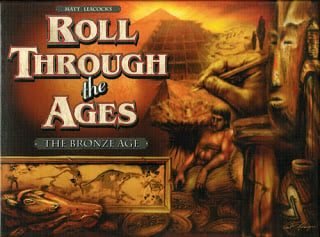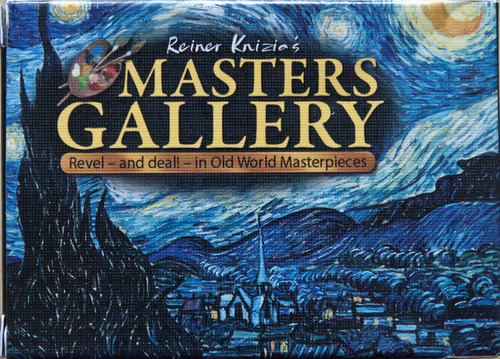
The Bronze Age occurred began in the 3000s B.C. It was characterized by the use of bronze, early writing systems, and the early features of urban civilization. The Bronze Age is considered the second major period of the three-age system (Stone, Bronze, and Iron). Matt Leacock (Pandemic master) took this concept and created the game Roll Through the Ages: The Bronze Age. This is the second game in Eagle-Gryphon Games' "Bookshelf Series." This series of games stand up on your shelf and look like one of those nice hardcover books you used to buy through the mail. This specific game is designed for 1-4 players, ages 8+. It takes 30 to 45 minutes to play, and it retails for $39.99.
Review
This is a very fun civilization building game that uses dice as your tools. The game has an old-time feel to it, because the components are wooden pegboards. This makes the box and the game heavy, but not unwieldy. Because it's a pegboard and there are no cards, you'll have to use your imagination a bit if you are the type who needs art and theme to make a game come to life.
The game play is very simple to learn, teach, and play, but there is a level of strategy and push your luck involved with every roll of the dice. Do you go for extra food this turn or try and build a city to get an extra die to roll? Be careful getting too many cities too quickly, because you're going to have to feed them. I personally prefer to buy building developments for those added bonuses and the protection they provide against disasters. I'm not very lucky with dice rolls, so if there is an ability I can buy that will mitigate bad rolls, you know I'll buy it! Speaking of disasters, it's not all bad news for you if the dice don't fall your way. If you roll three disasters, it will leave you alone and only mess with your opponents. Therefore, if you roll two disasters, it might behoove you to aim for three. You just better hope you don't end up with four.
The biggest complaints about this game are the downtime, lack of player interaction, and a a feeling that the games start to feel the same after so many times playing it. Luckily, there is an expansion, which you can buy for $5 or download for free. It is called The Late Bronze Ages, and it adds four new developments; makes trading between players a base rule; and puts all the monuments in play no matter how many players there are. These changes took a very good game, and made it into a great game. If you're interested in a civilization-building game with a Yahtzee-style game mechanic, then this is a game, you'll want to check out. Be sure to check out the sequel Roll Through the Ages: The Iron Age.
Learn more about how to set up and play the game.
[Tweet "Play games with history and art themes! @StuartsStudy reviews 2 games for players 8 and up!"]

When it comes to art, I admit that I am a bit of a snob, and have very particular tastes. I don't like modern art, maybe because I don't get it, and I don't see the appeal of Warhol, probably again, because I don't get it. When I heard that there was an older game (2009) that utilized works of famous artists (Van Gogh, Renoir, Monet, Degas and Vermeer), and that it was designed by Reiner Knizia, I knew I wanted to give it a try. The game is called Masters Gallery. It is designed for 2-5 players, ages 8+, and takes about 30 minutes to play. It is produced by Eagle-Gryphon Games, and retails for $25.99. In this game, you are an art critic/gallery owner. You have your favorite artist, but your opinion can be changed depending on how the market changes. Your goal is to have the most valuable collection of art in your gallery.
Review
The game is very simple to learn. All you do each turn is play one card. Those cards might give you a special ability, but that's it. However, the strategy in this game is deeper than it appears. With four rounds and no guarantee of when each round will end, you need to carefully choose which cards to play and which cards to keep. Add to that, you start with 13 cards, and as the rounds go on, you will have fewer and fewer cards at your disposal. The award tokens also stick around at the conclusion of each round, making this game more marathon than sprint.
Though the simplicity is a big selling point, I think what I like best about this game are the components, which are merely a deck of cards and some cardboard tokens. On the cards are famous works of art of five famous painters. This makes this an educational game, a family game, a strategic game, and a bit of a classy party game. You can learn about great art, while playing a game and having fun too, and if you get beat soundly your first time, the game is quick enough that you can simply play again and tweak your strategy.
On a final note, I would like to point out one of the few negatives of the game and that is "luck of the draw." The game is not random, because there is strategy to it, but at the end of the day, you can only play the hand you are dealt. If someone gets more of the cards with special powers on them, then they have a better shot at winning than someone who does not. This isn't as noticeable in lower player count, but in a high player count, it can make the game feel a bit more random and chance-driven. That complaint aside, I think this is a fun game and one that any art-lover needs.
Learn more about how to set up and play the game.
Your purchase of these games through our Amazon link supports CatholicMom.com.
See all the Favorite Games for Family Game Nights reviews here.
Copyright 2016 Stuart Dunn
About the Author

Stuart Dunn
Stuart Dunn was born and raised in Mobile, AL and received a Bachelor of Arts in Psychology and a Master of Business Administration from the University of South Alabama. Stuart reviews all things Catholic including adult books, children’s books, Bible Study series, Catholic Courses, CDs, and DVDs in addition to board games at his blog Stuart’s Study at StuartsStudy.blogspot.com.


.png?width=1806&height=731&name=CatholicMom_hcfm_logo1_pos_871c_2728c%20(002).png)
Comments